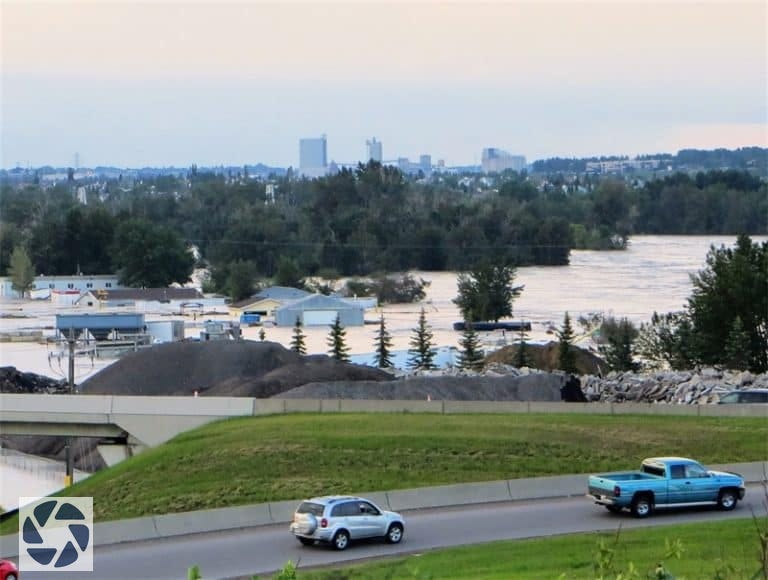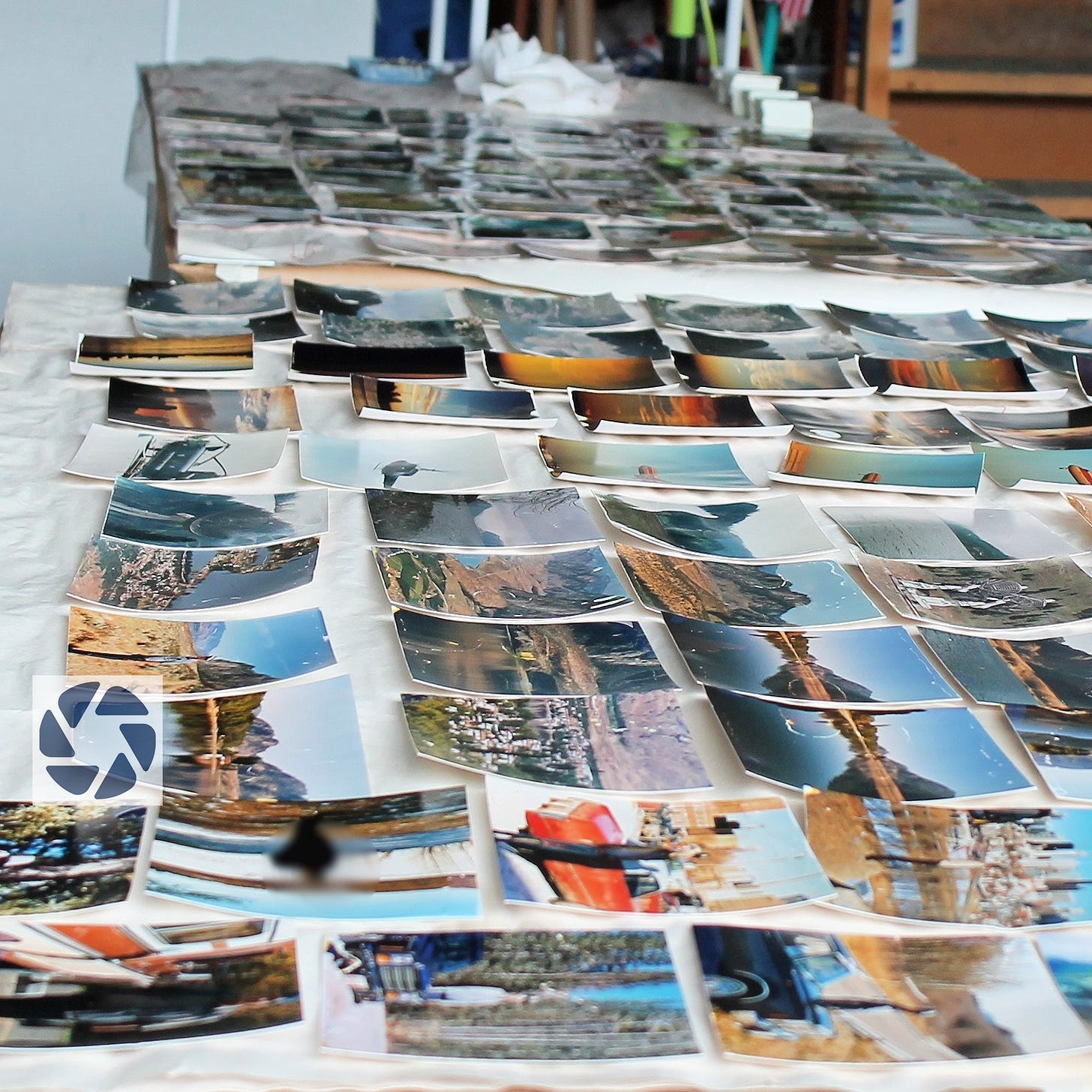This post first appeared on my website in 2015. I updated it in 2024 to add a section on smoke damage.
"When our house flooded, it wasn't losing the TV or furniture that bothered us most, it was the memories. We captured our memories in photos and although our thoughts could conjure up moments that were special, losing the physical picture was beyond traumatic to us."
– Martha K., resident of High River, AB (June 2013)
Floods, tornados, hurricanes, and wildfires seem to be occurring with greater frequency in recent years, and often our priceless photos and albums are the victims of these events. Or our photos are damaged by more mundane events such as leaky pipes, burst hot water heaters, and sewer backups. When these events occur, you need help and information right away.
This post provides tips for what to do when disaster strikes so you can reduce damage and increase the chances of salvaging your photos and albums. If you suddenly find yourself faced with wet, damaged photos and albums, here’s what you need to know to reduce damage to your photos and recover your precious images once the emergency is over.
First, here is what NOT to do:
1. Don’t throw away your wet, muddy or damaged photos or albums!
2. Don’t dry photos in their albums, in envelopes, or stacked together.
3. Don’t dry photos in a place with bright sunlight, wind, or dust.
4. Don’t dry wet photos without rinsing off mud and debris.
5. Don’t rub the photo surface with your fingers or a cloth.
6. Don’t pry wet or dry photos apart.
7. Don’t use cleaning solvents of any kind on photos.
8. Don’t use heat sources to dry photos (hairdryer, oven, microwave, etc.)
9. Don’t dry photos on printed newspapers or similar materials.
What to do first:
These tips are the first steps to take when your photos and albums get wet.
1. Wear gloves and a mask when handling wet photos and albums - particularly in cases of natural disasters or sewage backup.
2. Remove wet envelopes, folders, album covers and dispose of them. Take a picture of the album cover or envelopes if there is information about the contents on it.
3. Remove plastic covers and sleeves from photos where possible.
4. Put your wet photos and albums in plastic bags and freeze them. If possible, layer wax paper between individual photos or between album pages.
5. If you don’t have access to a freezer, put photos and albums in sealed plastic bags to try and keep them from drying out completely. These must be cleaned within 48 hours, as mold will begin to grow.
6. Focus first on the photos that you know have no digital backup or negatives.
7. Focus on the photos with the least amount of damage first.
8. If you have very old heritage photos, you may want to contact a professional photo restoration service.
9. Members of The Photo Managers can help you with recovering your photos. Locate one in your area here: The Photo Managers
How to clean your photos:
When you have time to deal with the photos and albums, follow these steps.
1. Gather the supplies and materials needed.1
2. Take safety precautions.2 Mold will grow in the photo substrate, pages of albums and other areas. It is very hazardous to your health. Unfortunately, you can’t use bleach or other mold remediation products on your photos.
3. Plan the order of cleaning and drying your photos: wet first, then frozen, then dry. Framed photos first, then prints with no negatives or damaged negatives, negatives, then all other prints. Note: Inkjet prints cannot be cleaned using this method.
4. Thaw frozen photos in small batches at room temperature out of plastic bags.
5. Scan or photograph photos that are stuck to glass or album pages, or that have significant damage BEFORE you clean them.
6. Remove photos from albums or glass frames – this may require soaking in clean water.
7. If photos are stuck together, soak in water until they can be separated.
8. Test your cleaning process on a few, less important photos first – do this for each kind of printed photo.
9. Rinse photos one at a time in clean, room temperature tap water. Gently rub any stuck dirt or debris with a soft brush, or swish in water if the emulsion is damaged.
10. Once dirt and debris are removed, swish the photo in clean, room temperature distilled water.
11. Change the water frequently.
12. Shake off excess water, and lay prints flat on layers of clean newsprint to dry. Photos can also be hung by a corner with a plastic clip to dry.
13. Wait until the prints are completely dry before stacking them.
14. Once dry, flatten under heavy books.
15. Scan the dry photos to create a digital back up copy.
Cleaning Smoke Damaged Photos
Set aside a clean, dry work area with good ventilation.
Remove as much soot from your item as possible. If there is extensive loose ash and soot on your item, use a vacuum cleaner and a soft, clean brush to gently brush dirt towards the vacuum nozzle. Turn the vacuum cleaner onto the lowest setting and attach a fine gauze or a piece of stocking over the nozzle to create a filter. This will prevent suction of your item into the vacuum. A vacuum fitted with a HEPA filter is recommended so that the dirt is not released back into the room. Do not place the nozzle directly on or too close to the item. Handle items gently as they may be brittle.
If there is a layer of dirt and soot on your items, you can use these products to remove the soot: a smoke sponge, (available at Amazon) or dry-cleaning sponge, made from vulcanized rubber — use without water and gently work over the surface to collect the soot; a kneadable eraser (available from art stores) can be used to remove soot by gently rolling it over the paper; a clean dry cosmetic sponge can be used in a similar way to the dry-cleaning sponge — these sponges can be washed, dried and re-used.
FAQ
What does freezing the photos do?
If you don’t have time to deal with your photos and albums immediately, freezing them halts the biggest threat to the destruction of photos – mold. Freezing doesn’t kill the mold, but it stops it from progressing. When you thaw out the photos to clean, the mold will start to grow again, so thaw your photos in manageable batches, not all at once.
Can I keep photos I have cleaned and dried?
It depends. There is no way to kill the mold on photos. It will dry and particles may stay on your photos. Placed in another situation with moisture (e.g. a humid house), the mold may grow again. I recommend that you scan the cleaned photos and dispose of the prints.
If I follow these steps, will I be able to save all my photos?
These tips are your best chance to salvage your photos and albums, but there are no guarantees. Some photos and albums survive floods with surprisingly little damage, some may be completely destroyed, and others will be somewhere in between. In addition, some types of photos are more easily damaged by water than others; Inkjet prints, for example, usually do not survive any time submerged in water. Fortunately, however, Inkjet prints have usually been printed from digital files and can hopefully be recovered from the original file.
What about movie reels and tapes?
These items are harder to clean and more fragile. It is best to consult a professional. There is a link to a resource to help in the reference section.
For detailed information, see these reference documents.3
Materials and Supplies:
Work tables
Gloves (latex or nitrile), rubber gloves, cotton gloves
Respiratory masks
Tyvek® suit or old clothing
Safety goggles
Plastic bins
Freezer bags, plastic bags, and garbage bags
Wax paper
Scissors, utility knife, pliers
Soft brushes
Microfiber cloths
Cotton swabs, cotton balls
Spatula (plastic or rubber)
Distilled water
Drying tables or hanging racks
Plastic clothes pins or plastic-coated clips
Clothes lines
Blotting paper, clean newsprint, plain paper towels
Masking tape, note paper, paper clips (plastic)
Permanent ink markers (such as sharpies), pencils
Empty photo boxes or shoeboxes
Negative envelopes
Scanner
Camera
Glass or Plexiglas
Heavy books
Safety Precautions:
· Wear gloves – rubber gloves for handling bags and containers of wet photos, taking albums apart, etc.; and surgical gloves for cleaning.
· Protect your clothing.
· Wear a mask.
· Wear goggles.
· Work in a well-ventilated area away from children and pets.
Resources:
Saving Wet Photos - National Parks Service
Helping Photos Weather the Storm - Pixologie Inc.
Photo Rescue Project - Fujifilm
Disaster Preservation FAQs - Library of Congress
What to do with Moldy Tapes - Kodak
Moldy Film and How to React - Regional Media Legacies Blog
© Kathy Stone, Calgary Photo Solutions, 2025








